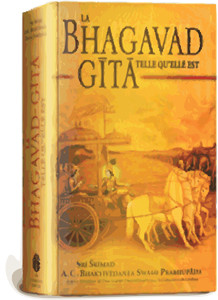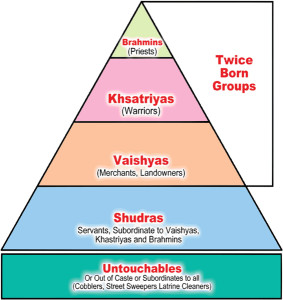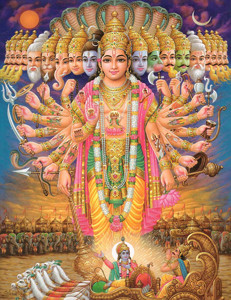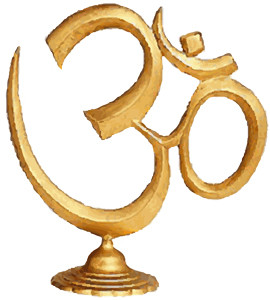Paul Derengowski, ThM
Historically speaking the term “Hindu” or “Hinduism” is of relative recent ascription. During the time of British invasion of India during the Industrial Revolution of the 1800s the term Hindu was assigned to those who lived in the Indus Valley along the river Ganges. In fact, Hindu means “river” in both the Persian and Sanskrit. Prior to that those who comprised the Indian cultures were of Dravidian (Dasas) or Tamil descents that were influenced by Aryanism stemming from the 15th century B.C.E.
 Hinduism itself is a conglomerate of several different religions and ideas starting with the invasion of the Aryans who brought with them the Vedas and Vedic traditions. The word veda literally means “knowledge,” and the Vedas consisted of four collections (samhitas) of writings: the Rig-Veda, Sama-Veda, Yajur-Veda, and Atharva-Veda. Later the Brahmanas, Upanishads, and Sutras were added to the Hindu texts. All the aforementioned were also known as Shruti texts, or “that which is heard.” Additionally there was the Shmriti texts, the Ramayana and Mahabharata (which contains the Bhagavad Gita), which means “that which has been remembered.”
Hinduism itself is a conglomerate of several different religions and ideas starting with the invasion of the Aryans who brought with them the Vedas and Vedic traditions. The word veda literally means “knowledge,” and the Vedas consisted of four collections (samhitas) of writings: the Rig-Veda, Sama-Veda, Yajur-Veda, and Atharva-Veda. Later the Brahmanas, Upanishads, and Sutras were added to the Hindu texts. All the aforementioned were also known as Shruti texts, or “that which is heard.” Additionally there was the Shmriti texts, the Ramayana and Mahabharata (which contains the Bhagavad Gita), which means “that which has been remembered.”
Religious Order Developments
The Aryan social system consisted of four orders: the Brahmins, Kshatriyas, Vaisyas, Shudras, and Untouchables. Each of these order eventually developed into the Indian caste system (later known as jatis or kin group), which although it has undergone some reform, is remains influential in social affairs even unto today. Those born into a particular caste were confined to that caste for life, with marriage outside the caste forbidden.
The Brahmins were the priestly caste which held powerful positions of influence in the area of religious rites. In fact, early on the Brahmins began to usurp such power and authority that they became more important than the gods and goddesses. The ritual and formulas prescribed by the priests were of more significance than recognition of those to whom the sacrifices were performed. Eventually the priests became so enamored by performance of the religious rituals that they authored the Brahmanas, which were tantamount to magical incantations thought to contain the words necessary to manipulate the created order.
The Kshatriyas were the warriors or warrior-chiefs, and were second in importance among the caste structure. Their role was to protect the rest of society. They were also comprised of the ruling aristocracy. According to Vedic tradition Lords Rama, Krishna, Buddha (Buddhism), and Mahavira (Jainism) all belong to the Kshatriya caste.

The Vaisyas were the landowners, businessmen, and artisans. They were the common people, in other words, coming from all walks of life. According to Dr. R. K. Lahiri the Vaisyas “deal with wealth and gold and strive for material prosperity of the self as well as of the people in general.”[ref]R. K. Lahiri, “Caste System in Hinduism,” <http://www.boloji.com/hinduism/108.htm>.[/ref] Also, “Those Brahmins who derived their livelihood from kine, who were yellow and sub-divided by agriculture and who neglected to practice their duties, fell into the category of Vaisyas.”[ref]Ibid.[/ref]
Fourth, there was the Shudras, who were the working-class servants; the manual laborers that catered to the upper castes. They were the peasants who did menial work. They pale by comparison, though, to those known as the Untouchables.
The Untouchables (dalit) were the low-life and wretches of society. They were the ones who performed “the foulest, most polluting of tasks.”[ref]John Bowker World Religions (New York: DK, 2006), 20.[/ref] Their duties included, “cleaning toilets, sweeping streets, collecting animal carcasses, and tanning animal hides.”[ref]Michael Molloy, Experiencing the World’s Religions (New York: McGraw-Hill, 2008), 89.[/ref] Moreover, they were restricted from living within the boundaries of a village.
Later Mahatma Ghandi deemed the outcastes as Harijans, or children of God, and attempted to incorporate them into the fourth class, or Shudras. His attempt failed. In 1950, however, Indian Constitutional provisions outlawed untouchability, even though they continue to struggle with tradition.
Primary Gods & Goddesses
Within the Hindu pantheon are literally millions of gods and goddesses, all of which have some association with the created order. Early on Brahma(n) was seen as the most powerful and authoritative of the gods, but his identity slowly changed, even though he is still credited with creation and order in the universe. Creation is used lightly here since Hinduism also espouses an eternal, monistic conception of all things, or that nothing was really created, but has always existed. Other gods and goddesses of prominence were:
 Vishnu, the protector and preserver.
Vishnu, the protector and preserver.
Shiva, the destroyer.
Krishna, the 8th or 9th incarnation of Vishnu.
Sarasvati, the consort of Brahma.
Laxmi, Vishnu’s wife and provider.
Kali, Shiva’s consort.
Devi, “the Great Mother.”
Durga, the “awe-inspiring” goddesses with 10 arms.
Indru, the chief administrator of heaven, and the god whom Hindus most often pray to.
Agni, the god of fire and life force of nature.
Hindu Worship
Hindu worship is essentially practiced in two forms: communally and individually. The communal form of worship takes places in a Hindu Temple. The motivation is to be seen in the presence of the deity of one’s choosing. Typically this is done by alerting the deity through chanting a mantra or other practices such as ringing a bell. Communal worship, though, is the less popular of the two forms of worship, probably because of Brahmin (priest) abuses earlier in the development of Hindu religious practices.
The more popular form of worship is carried out within the homes of Hindus worshipers. A small private shrine is typically constructed and dedicated in a specially designated room in a house or living quarter where a worshiper places his sacrifice or offering on an altar. The sacrifice usually includes either some kind of grain or candy, and it is assumed that the deity consumes the essence of the offering and leaves the remainder for the worshiper to consume later.
Also important in Hindu worship is the involvement of images, prayers, and diagrams. The images involve those displays of the gods. In private worship small figurines often adorn the altar. Prayers include mantras along with gift-giving, or what is also known as prasad. The diagrams or yantras are often drawn on the floor in the shape of a Hindu temple structure, which would involve a circle within a square that is inside a triangle.
Four Stages of Life (ashramas)
Hindus believe that all males progress along in distinct stages in life. In the early years all males are students or Brahmacharya. It is during this stage that a male receives his formal education just before he enters adulthood. The second stage involves the male marrying (Grhasta). During his married years the male attempts to pay his Three Debts (to God, to the saints and gurus, and to ancestors) and then live according to Hindu standards. Third, as life begins to approach middle-age the male begins to live as a hermit (Vanaprastha). He involves himself in more self-study and meditation, preparing himself for the fourth stage: the mendicant. As a mendicant, or beggar, the male attempts to completely withdraw himself from not only society, but from his immediate family as well. He sole focus is on spiritual contemplation and the preparation to die, with the express hope of attaining moksha or release from the birth-death cycle of reincarnation.
Four Goals of Life (purushartha)
 In conjunction with the Four Stages of Life are the Four Goals of Life. The first goal is achieve Kama, or the guided pursuit of pleasure through love. Second is the goal of Artha, or the pursuit of economic security and power. Third is Dharma, or the pursuit of satisfaction in life through religious devotion and social responsibility. Last is Moksha, or the complete release or liberation from the cycle of death and rebirth, with the ultimate prospect of being absorbed in the great “Self,” which is typically Brahaman.
In conjunction with the Four Stages of Life are the Four Goals of Life. The first goal is achieve Kama, or the guided pursuit of pleasure through love. Second is the goal of Artha, or the pursuit of economic security and power. Third is Dharma, or the pursuit of satisfaction in life through religious devotion and social responsibility. Last is Moksha, or the complete release or liberation from the cycle of death and rebirth, with the ultimate prospect of being absorbed in the great “Self,” which is typically Brahaman.
